
views
Dyeing Prep
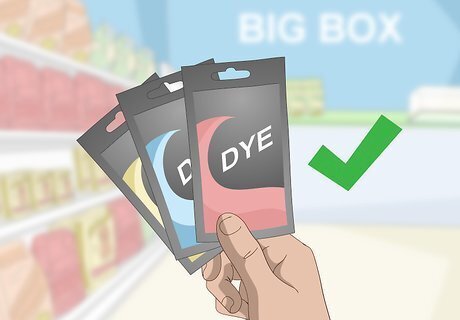
Purchase a commercial dye from a big box store. All-purpose clothing dyes are available at most big box stores. Rit, one of the most popular brands, is widely available in a large selection of colors. Dylon is another common brand. Craft stores carry a bigger selection of colors than big box stores generally do. These dyes come in powder or liquid form, and either one will work just fine.
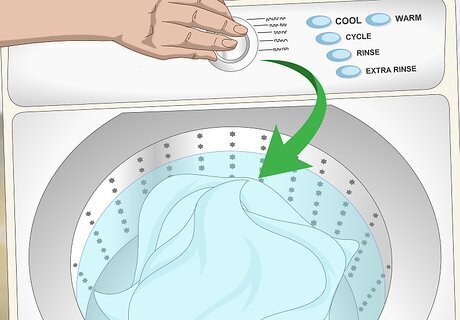
Wash the fabric. You need to start with clean fabric, so wash it if you're using something you already have. It's a good idea to wash new fabric as well, just in case it has anything on it that could keep the dye from sticking. Don't dry the fabric, as you'll need it wet to dye it. Don't use fabric softener.
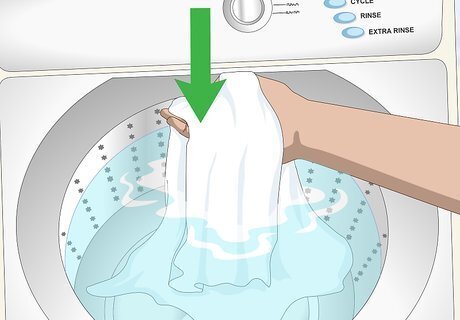
Soak the fabric if it's not saturated with water. The fabric needs to be completely wet so that the dye doesn't create a splotchy effect on the fabric. You can take the fabric out before the spin cycle or soak it in a tub before dyeing it to saturate it.
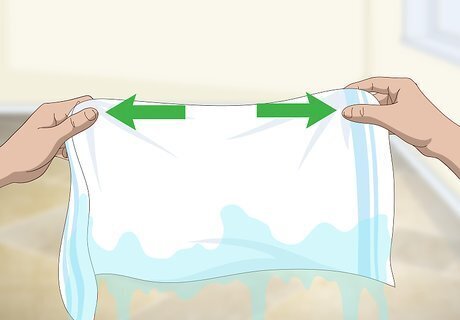
Smooth out the fabric. If you put crumpled fabric in dye, you'll end up with a marbling effect. Unless you want a marbled look, use your hand to smooth out your fabric as much as you can before dyeing it.
Using a Bucket

Mix the dye with water and salt. Before mixing the dye into the bucket or sink, it helps to premix it in less water. Pour the packet or dye into 2 cups (0.47 l) of water in a small container. If you want the dye to be more intense, you can add 1 cup (0.24 l) of salt to some dyes. Read your dye's instructions to see if yours can take salt.
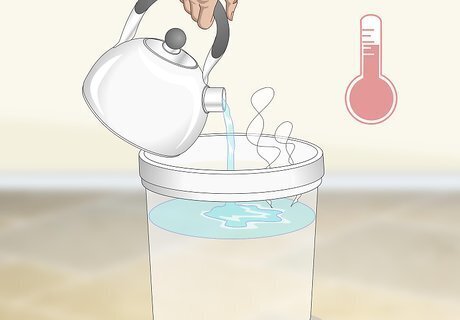
Add hot water to the bucket. You'll need to pick a container big enough for the cotton to soak in. Pour in enough hot water to cover the fabric you'll be dyeing. You don't want it boiling, but it should be very hot. Close to boiling should be enough. Also, read the back of your dye package to make sure you get the concentration correct. For instance, Rit dye is often one packet to 3 gallons (11 l) of water. However, you can use more or less water depending on how concentrated you want the color.
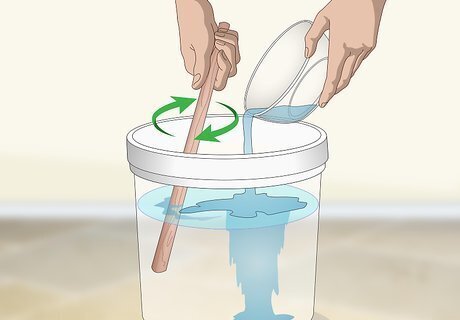
Add the dye to the bucket. Pour in the dye you've already mixed with water. Stir in the dye to incorporate it into the water in the bucket. Use a stick to stir so you don't get dye on your hands.

Submerge the fabric in the dye bath. Once the dye is thoroughly mixed in, place the fabric in the water. Use the stir stick to submerge the fabric. You can also use your hands, as long as you have latex, rubber, or nitrile gloves on.
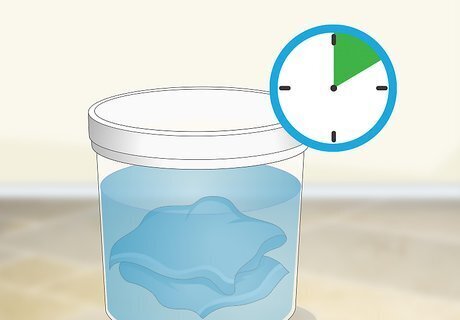
Let the fabric soak. The fabric needs to soak in the dye mixture for at least 10 minutes. However, you can leave it in there longer, depending on how dark you want your fabric.
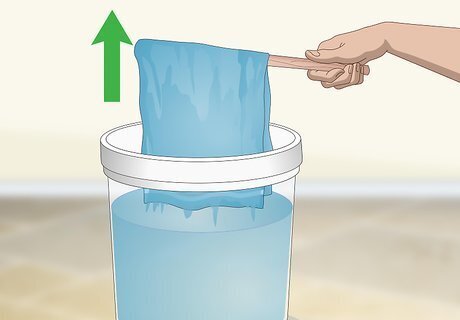
Take out the fabric when it's your preferred color. Keep checking on the fabric to see if the color is right. When it is, pull out of the bucket using the stick or your gloved hands.
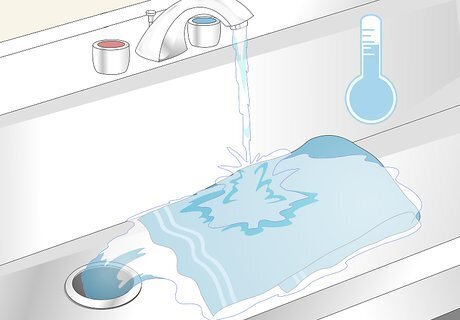
Rinse out the dye in cool water. In a sink, rinse the fabric under cool, running water. When the water runs clear, the fabric is done and ready to be washed.
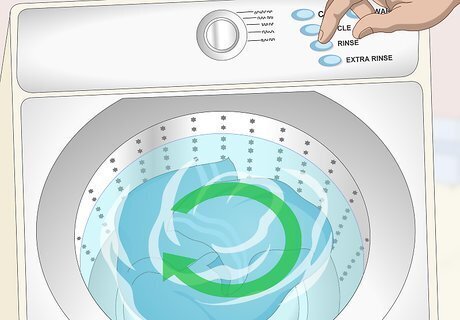
Wash and dry your fabric as you normally do. Once the dye is rinsed out, you can just run your fabric through the washer and dryer. You can even use regular detergent.
Using a Washing Machine

Start the washing machine on a long wash cycle. Set the washing machine to a washing cycle of 30 minutes or longer with hot water. If your machine doesn't have this option, you'll just need to reset it a few times before it moves on to the rinse cycle, which will require you to babysit the machine a bit. Unless you're dyeing something very large, use the lowest load size on your machine.
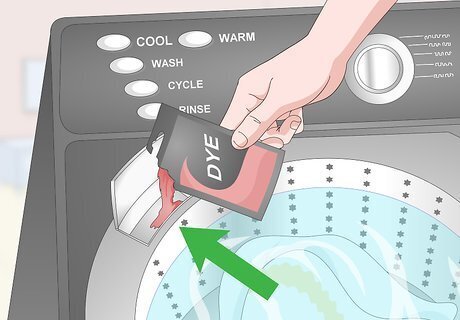
Pour the dye into the dispenser. Add the dye as you would detergent. You want the water to be running a bit so the dye won't clump and create blotches on your fabric, particularly if you're using powdered dye. Fill the bottle with water and pour it in after the dye. Repeat if you're using two bottles. You add water to the bottle to make sure you're getting all the dye and to ensure the chute is rinsed out completely.
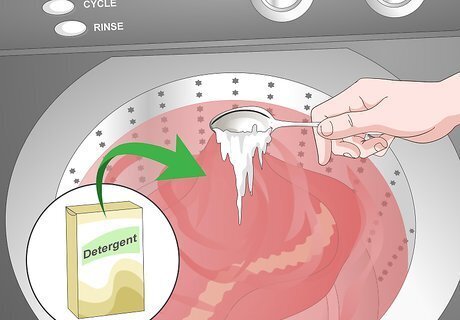
Add 1 tablespoon (15 ml) of detergent. While you don't want to add a full scoop of detergent, a little detergent is beneficial. It helps move the dye around evenly in the water.
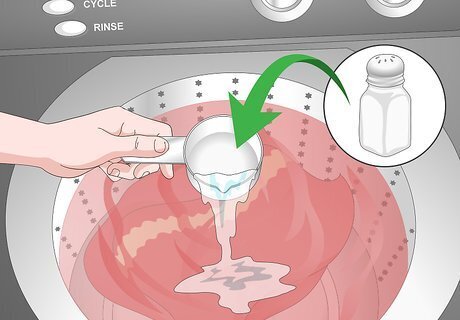
Pour in 1 cup (240 ml) of salt dissolved in water after 10 minutes. Stir 1 cup (240 ml) salt into 4 cups (950 ml) of hot water. Pour the mixture into the dispenser about 10 minutes into the cycle.
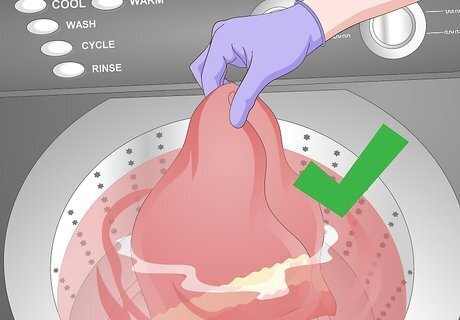
Check the fabric. Keep checking on the fabric until it's the color you want. When it is, you can let it finish running through it's wash cycle. Generally, you want the fabric to stay in the dye at least 30 minutes before the rinse cycle kicks in but not longer than an hour.
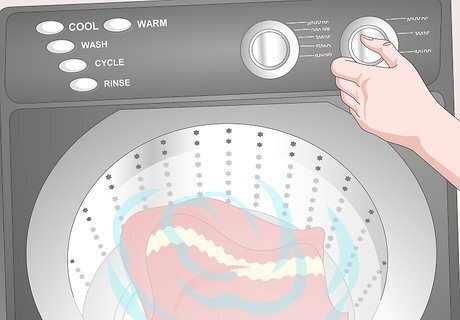
Wash and dry as normal. Once the fabric has gone through a long washing cycle, add detergent and wash it again. Pop it in the dryer when you're done, or let it air dry.
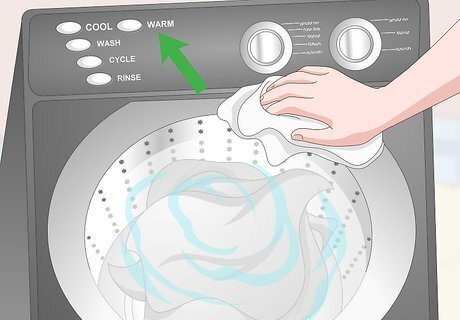
Clean out the washing machine. Turn the washing machine on its highest load setting on hot. Wipe down around the lid and top, and pour water through the dispenser to clean it out. Pour in 1 to 2 cups (240 to 470 ml) of bleach, plus a standard amount of detergent. Throw in a couple of old towels or a load of old rags and run it through a washing cycle.
Other Dyeing Options
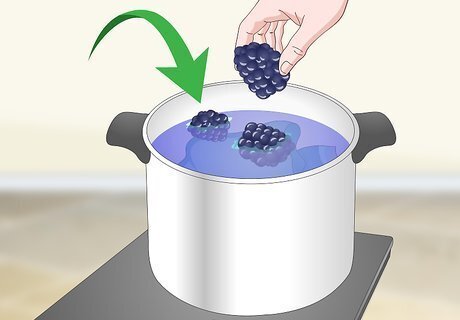
Make a natural dye for an economical dye. You can use items from nature to make a dye. For instance, you can use berries, flowers, bark, leaves, and nuts. Keep in mind that the color of the flower or berry may not be what you end up with as an end result. For instance, you can get light pink from avocado skin and seeds. Cherries or strawberries will also dye something pink. Blackberries or blueberries will give a bluish purple. Crab apple bark will make a reddish brown, while pokeweed berries will make a red-purple. Artichokes, grass, and foxglove flowers will all give you a shade of green. The possibilities are endless, so try looking up a recipe online to find the color you want and to help you identify appropriate plants. Cut the plant material into small pieces. Use 1 part plant material to 2 parts water. Boil it together for an hour, and then strain out the plant pieces. To set the dyes, dip the fabric in a mordant before the dye. For berry dyes, you can use 8 cups (1,900 ml) of water and 0.5 cups (120 ml) of salt. For plant dyes, try 1 part vinegar to 4 parts cold water. Simmer the fabric in the mordant for an hour. Rinse it out, and place it in the dye bath and simmer for an hour.

Try using acorns to dye fabric a dark purple-black. Start by making an iron solution. Place rusty items (such as nails, bolts, and screws) in 1 cup (240 ml) of white vinegar. Let it sit in a jar in the sun for 2 weeks until the vinegar is orange, and then strain out the metal. Place 5 pounds (2.3 kg) of acorns in a pot of water large enough for the acorns to move freely. Let the acorns simmer for 2 hours. Strain out the acorns. Keep the acorn mixture warm. Dip your fabric in, leaving it for 30 to 45 minutes. Squeeze out the dye, and dip it into the iron mixture (in a bowl) for 10 minutes. Go back and forth, leaving it in each mixture for 5 minutes until you reach a color you like. Squeeze it out between each dip. At the end, squeeze the fabric again. Let the fabric dry for an hour, and then wash it out in cool water with soap.
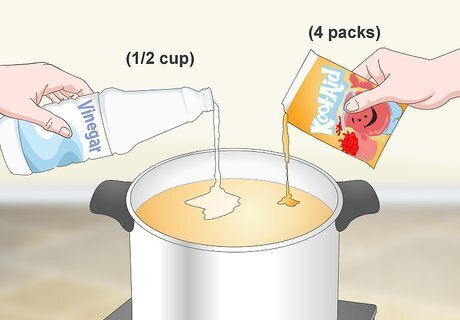
Use flavored drink packets for a more temporary dye. To make the dye, mix 4 drink packets into 0.5 cups (120 ml) of white vinegar and 1 gallon (3.8 l) of water. Boil the mixture with presoaked fabric for about 25 minutes, until the water runs clear. Let the mixture come to room temperature, then place the fabric in a bowl of clean room temperature water. Squeeze to release as much dye as you can. You may need to change out the water. When you add new water and it stays clear, squeeze out the fabric, and let it dry. Unsweetened flavored drink packets, such as Kool-Aid or Flavor Aid, will color cotton. However, the color will fade over time.

Dye with tea or coffee. Boil enough water to cover the fabric. Add in enough cheap tea bags or instant coffee to change the color of the water. You can try 40 tea bags or 0.5 cups (120 ml) of instant coffee for a medium pot of water. Tea will often create a stronger dye due to the tannins in it. Steep the clothes in the solution for an hour or longer. The longer you soak the fabric, the darker it will be. When the fabric is as dark as you'd like, squeeze out the dye, and run it under cold water. Soak it in a bit of white vinegar for 10 minutes to help set the color. Rinse out the vinegar and then let the fabric dry. You can also iron it to get out the wrinkles. Tea or coffee can be used to give fabrics a vintage look. You can also use them to hide stains on white towels that have seen better days.




















Comments
0 comment